|
A lot has been happening in Urban and Community Forestry this year.
If you have not heard already, the Biden-Harris administration has invested over $1 billion in Urban and Community Forestry nationwide. This has occupied the time of many state coordinators over the last few months, myself included. State program managers have worked hard to put together proposals that were inclusive and aimed at increasing canopy and providing tree equity. The Council on Environmental Quality provided a map tool that can be used to identify communities throughout the state which qualify as disadvantaged or partially disadvantaged, it is called the Climate and Economic Justice Screening Tool (CEJST). You can visit the tool and look at the areas in Idaho that fall into these distinctions here.
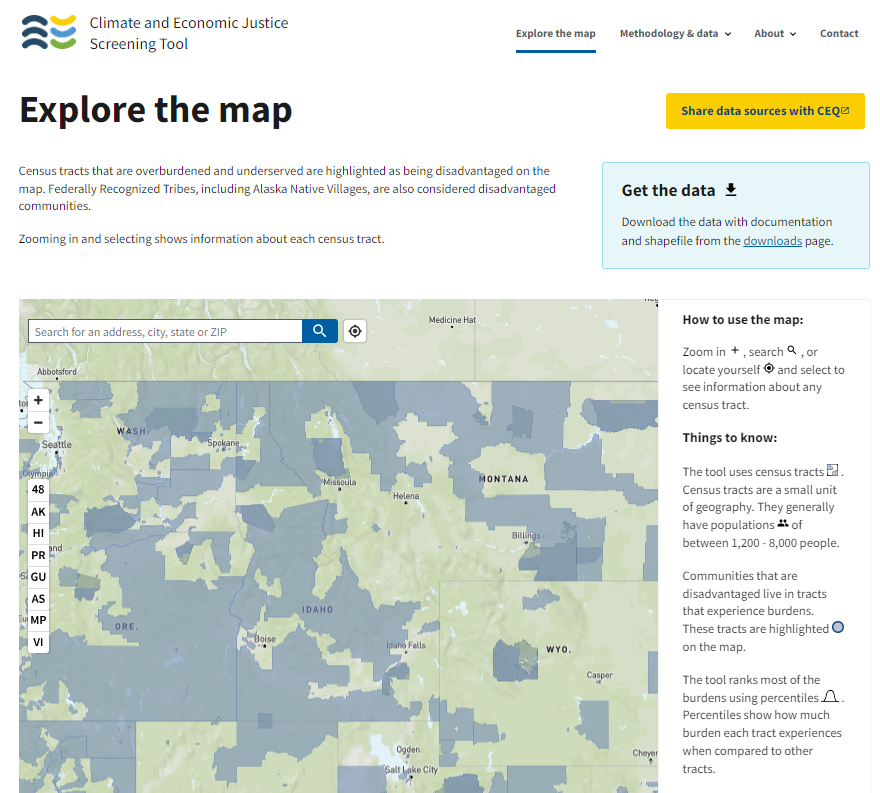 Large portions of Idaho will qualify for assistance through the IDL Inflation Reduction Act funding, with the exception of the most populous parts of the state.
Idaho was awarded $750,000 to build a sub-grant program that will help communities across the state complete tree inventories and identify projects aimed at creating healthier, resilient urban forests.
Eligible activities that will receive funding include, but are not limited to, workforce development, urban forest inventory, tree risk mitigation, exotic pest management, urban wood utilization, urban food forests, tree planting targeting increased species diversity, and reducing urban heat island effects. The expected release of the first RFP/RFA will be on or before 12/29/2023.
Notification of Statewide Funding Opportunities will be announced during the Fall/Winter season each year for the following three years or until funds have been exhausted. Awards will be distributed on a competitive basis each spring and communities will have one to two years to complete projects, to allow for inspections and final reporting.
IDL UCF hopes to provide many additional arborist training and education opportunities across the state. Workshop topics will include professional tree climbing and rigging practices, tree maintenance best management practices, tree risk assessment and certified arborist accreditation.
There will also be funding opportunities for work that targets tree risk mitigation and increasing species diversity among urban forests. All work will align with and focus on achieving goals that are outlined in Idaho's Forest Action Plan, the 10-Year Urban and Community Forest Action Plan, the Justice 40, and the America the Beautiful Initiatives.
For more information about the Idaho IRA program reach out to the IDL UCF Program Manager Matthew Perkins at mperkins@idl.idaho.gov
Idaho had 61 communities recognized as a Tree City USA in 2022. Collectively, these communities invested over $8 million in urban forest management, planting 4,300 trees and pruning over 23,000 trees. The average per-capita spending of Tree City USAs in Idaho was $8.13.
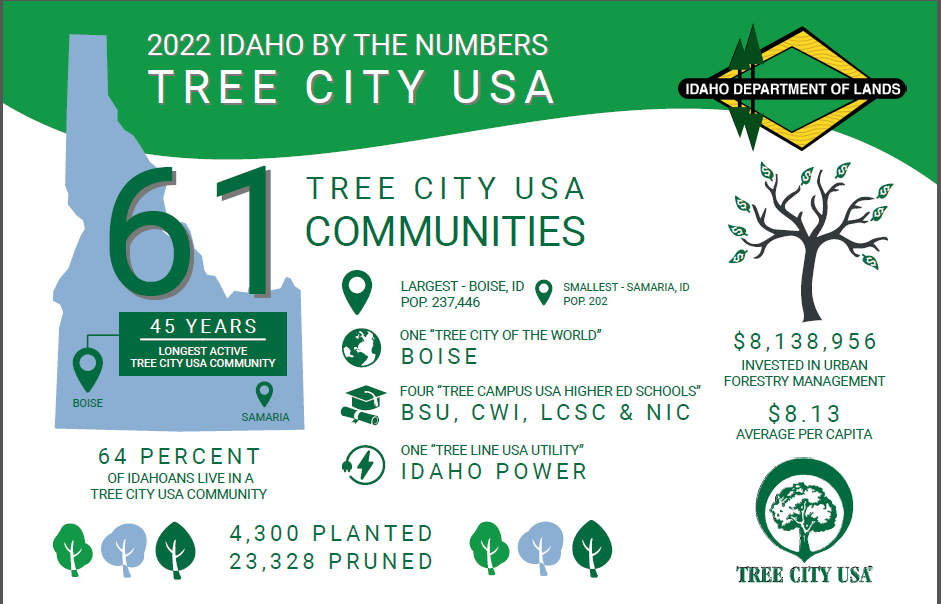 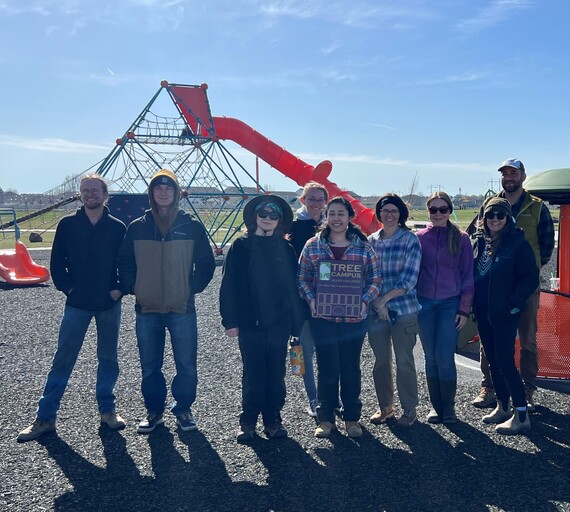 Students from the College of Western Idaho Horticulture Program with the plaque from their first year being recognized as a Tree Campus USA Higher Education college. Photo by MP
The College of Western Idaho was recognized for the first time this year as a Tree Campus Higher Education college. They celebrated Arbor Day this year by helping the City of Nampa plant over 100 trees in a new park. The city organized an event that included over 200 volunteers that helped plant the trees in the new Orah Brandt Park on Cherry Lane in Nampa.
Idaho currently has four colleges and/or universities that have received Tree Campus Higher Education recognition - they are Lewis Clark State College, North Idaho College, Boise State University and College of Western Idaho.
To receive recognition as a Tree Campus Higher Education a school must meet five overarching standards:
1. Establishment of a campus tree advisory committee
2. Provide evidence of a campus tree care plan
3. Verify the plans annual dedicated expenditures
4. Hold an Arbor Day observance
5. Create a service-learning project aimed at engaging the student body
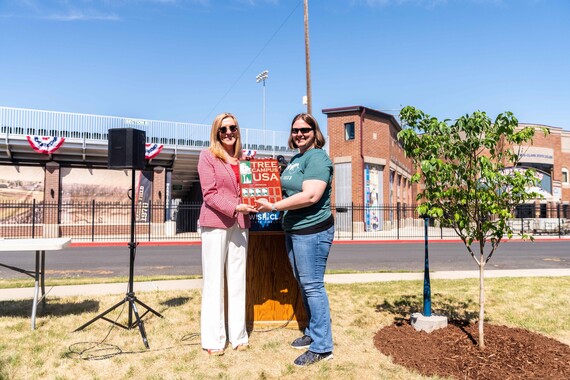 Lewis Clark State College President Cynthia Pemberton and Arborist Carrie Kyser celebrate 4 years of recognition as an Arbor Day Foundation Tree Campus Higher Education Facility.
Arbor Day at Lewis Clark State College (LCSC) was celebrated on campus this year by students honoring a member of the community and employee of the college with a ceremonial tree planting. David Walker has been a longtime supporter of the students and all their activities, attending nearly all of their events.
The tree planting ceremony kicked off the week of National Association of Intercollegiate Athletics (NAIA) World Series that is hosted by LCSC. A Flowering Dogwood tree (Cornus florida) was planted, Dave's favorite tree, and the subject of the Dogwood Festival held in Lewiston every spring.
The local news station in Lewiston KLEW covered the event, here is a link to the story: KLEW Community Hero David Walker.
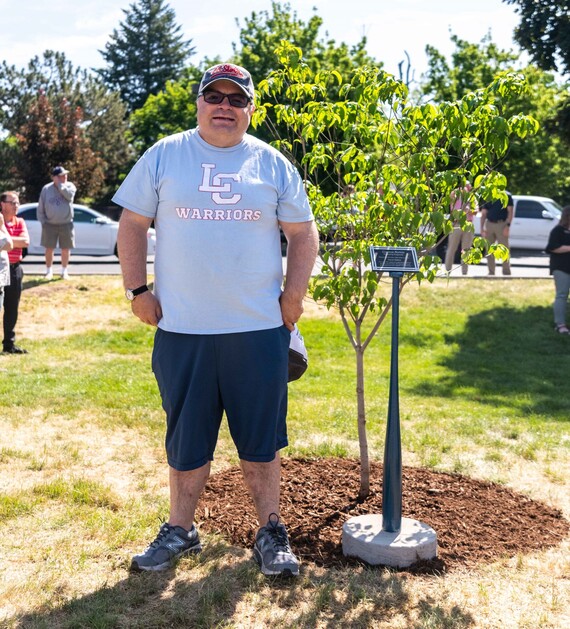 Dave Walker next to the tree that was planted in his honor during the Arbor Day celebration at LCSC. Photo provided by LCSC.
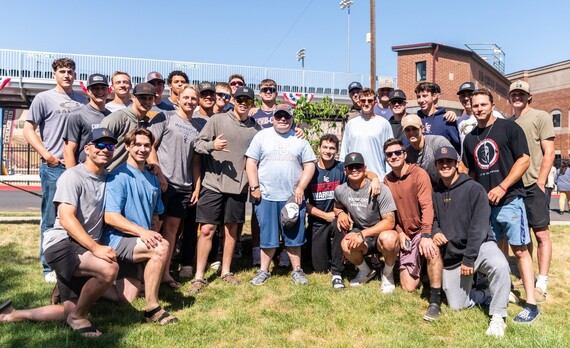 LCSC student athletes posing with Dave during the Arbor Day celebration. Photo provided by LCSC.
Arborist Certification Preparation Workshop and Testing
IDL UCF is working on putting together another round of workshops aimed at preparing arborists who wish to take the ISA certification exam. There will be two workshops offered this September, one in Southern Idaho and one in North Idaho.
There will be no charge for the course, attendance will be limited, all arborists will be welcome and CEU's will be available for those who are already certified. However, priority will be granted to those who are not yet certified and are signed up to take the test.
This is very critical; arborists who plan to take the certification exam at the end of the preparation course will need to follow the ISA Application procedure prior to signing up for the class.
Follow this link to the credential page where the application process begins: ISA Credentials/Exam Information
 |
|
The International Society of Arboriculture released the 4th edition of the Arborist's Certification Manual, which has meant reviewing older PowerPoint presentations to make sure information is still consistent with the new edition.
IDL UCF also hopes to host the same course for aspiring arborists in our Spanish-speaking communities.
|
Southwest Idaho's course will be held in Boise at the Idaho Fish and Game building on Walnut Street September 6-8.
North Idaho's course will be held in Coeur d'Alene September 14-15 at the IDL office on Industrial Way.
For more information on the classes visit the IDL UCF Page or reach out to:
South Idaho Community Forestry Assistant Gerry Bates gbates@plantingidaho.org
North Idaho Community Forestry Assistant Garth Davis garth-davis@spokanecd.org
IDL UCF Program Manager Matthew Perkins mperkins@idl.idaho.gov
Gold Medal of Horticulture
The Idaho Nursery and Landscape Association has an award program called the Gold Medal of Horticulture. It’s a prestigious award given to deserving individuals in the horticulture industry of Idaho. In their lifetime they have generously and selflessly contributed to horticulture in Idaho. Winners are chosen by a majority vote of the INLA Board of Directors. Gold Medal of Horticulture winners are given an honorary individual membership in the INLA for life.
The most recent recipient of this award was presented to Dr. Steve Love at the University of Idaho’s Aberdeen Research and Extension Center. Dr. Love graduated with degrees in horticulture from both Brigham Young University and Clemson University. After graduation, Dr. Love took a position with the U of I where he began a career that has spanned 38 years. Dr. Love is co-leader of the UI Horticulture Team and provides teaching and administrative support for statewide research and outreach programs. His subject matter specialties are landscape maintenance and small-scale production of vegetable crops.
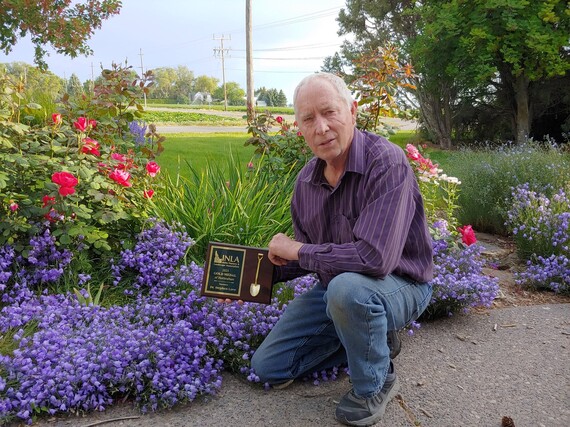 Dr. Steve Love with his Gold Medal of Horticulture. Photo provided by Idaho Nursery and Landscape Association.
Dr. Love operated a unique research program emphasizing domestication of native plants for the creation of sustainable home and commercial landscapes. This is where his passion for native plants intertwined with the INLA. Dr. Love’s research would expand plant material to include native plants that homeowners found attractive and an excellent way to lower water consumption. INLA began to support his research projects in 2007.
A variety of horticulture research projects are conducted at the Aberdeen Research and Extension Center, including applied research on use of native plants in low-water landscapes and accessions of native wildflowers, shrubs and trees for adaptation to southern Idaho.
Dr. Love has been a perennial presenter at the Idaho Horticulture Expo where he provided advanced training for early professionals. In 2013 he helped INLA start a program that would offer education on plant basics that was entitled “Green Collar College”. This program continues to this day, offering education to people who are new to Horticulture/Arboriculture and is one of the most attended series of the INLA’s annual Horticulture Expo.
With his expertise Dr. Love authored a chapter on Native Plants for the Certified Nursery Professional manual. He has supported the Green Industry in Idaho and the INLA and the Idaho Community Forestry Program and we’re and pleased that the Gold Medal of Horticulture has been awarded to him.
-Gerry Bates, South Idaho Community Forestry Assistant
Tree Tips:
Tree Disease and Insect issues that are becoming more frequent in the Treasure Valley
Have you noticed dead pine trees scattered throughout the valley while you have been driving around? Do you have one on your own property?
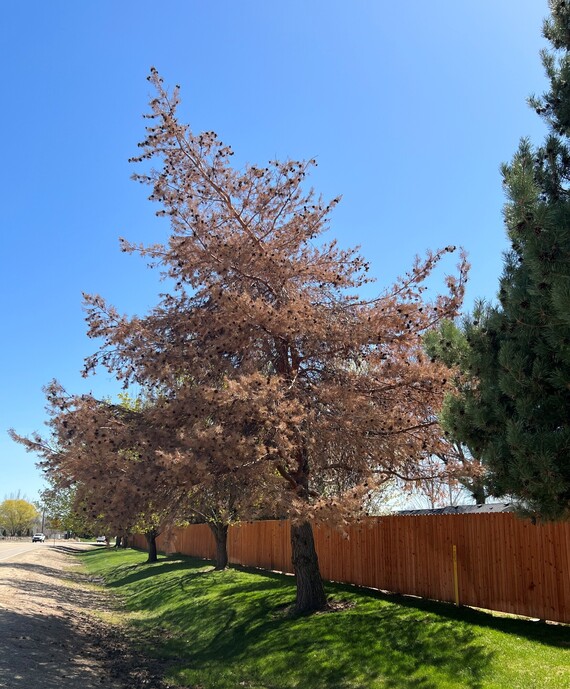 As was determined by the size and number of exit holes along the trunk of this Scotch Pine the 5-Spined Pine Engraver was present. I did not see evidence of the Pine Sawyer Beetle, but a closer examination after removal may prove differently. Photo by MP
Perhaps you have not been afflicted by the "disease" that most arborists develop after making tree work their passion. You know, the one that means it's a good thing we don't have sunroofs in our vehicles as we drive through our communities? We would get into a lot more accidents as our attention is taken off the road by the sight of an incorrectly pruned tree, a hazardous limb that dangles over the roadway, or even a dead tree that has not been removed.
There has been an increase in the occurrence of a new issue for pine trees in the Treasure Valley, in particular Scotch Pine, but Austrian and White pines as well. Keep an eye out for these issues to start showing up in other parts of the state.
Death of trees is rarely caused by just one pest or disease, instead there are multiple factors that accumulate and contribute to what arborists call a "mortality spiral". For this article I will be discussing a few specific culprits, the symptoms can be identical and tricky to differentiate between, but they all result in the death of the affected tree.
The first one is Ips grandicollis, commonly known as the eastern fivespined ips, also referred to simply as a bark beetle. I started to encounter this pest more frequently back in 2015 when I was an Inspector for Boise Community Forestry. I found a Scotch Pine in Julia Davis Park that was infested, and when our crew removed the tree, I kept a sample and took it into the entomologist at the USDA Forest Service. We dug under the bark together and carefully pulled out some of the beetles, to put them under a microscope and count the number of spines on the end of the abdomen. This is the only way to truly, and positively, identify the pest.
The adult, pupal, and larval form of Ips grandicollis. Image Source: Erich G. Vallery, USDA Forest Service - SRS-4552, Bugwood.org
What is often noticed first are the tiny pencil tip sized exit holes and/or pitch tubes along the trunk. Unless the problem is detected in the very early stages, once a tree is infested there is no way to save the tree. This is because by the time we notice the tree showing symptoms, the damage from the beetle larvae is too extensive.
The best thing you can do is protect your trees with preventative treatments before they get attacked. It would be prudent to seek recommendations from a professional applicator, who is also a certified arborist and familiar with tree pests and diseases. They will be able to administer treatments to help protect your trees.
Keep in mind that healthy vigorous trees are less affected, as the beetles are more attracted to trees that are stressed out due to adverse growing conditions such as compacted and drought-stricken soils. These conditions have become a lot more common in the Valley so, make sure you water your trees!
The next issue involves the Pine Sawyer beetle and is more complex. I confess that I don’t entirely understand it yet myself, but I think it is worth mentioning because apparently there seems to be a connection between the Ips and the Pine Sawyer. Which one attacks the tree first or is attracted because of the other has not been made clear. Both pests are commonly found infesting the same trees and it is believed they may be competing for the energy-rich tree resources.

The Pine Sawyer Beetle is much larger than the Ips in both its adult and larval form. Adult beetles attack a tree by chewing “egg niches” into the bark of trunks or limbs, in which it will lay eggs. Upon hatching, the larvae then begin tunneling under the bark feeding in the nutrient-rich phloem tissues.
Photo of an adult Pine Sawyer from Tom Eckberg, IDL Forest Health
|
Egg niche in a Scotch Pine made by an adult Pine Sawyer, where eggs are laid. Photo credit Tom Eckberg, IDL Forest Health.
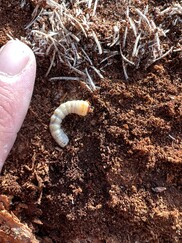
As they feed, Pine Sawyers create a fibrous waste that differs from the typical sawdust-like frass common with Ips grandicollis. These “strips” of fibrous frass can be a great identification feature that will confirm the presence.
As the larvae increase in size they begin tunneling deeper in toward the heartwood, then return closer to the bark surface to construct pupal chambers where they will complete the transition into an adult and emerge to repeat the process.
I have stood beneath a tree infested with these larvae and could hear them scratching about in their galleries, and it was enough to give me the heebie-jeebies!
Photo of a pine sawyer larvae next to my finger for size, and an example of the "strips" of frass they generate while feeding. Photo credit MP
|
As if the damage caused by these two wood borers is not enough, there is an additional pest that hitches a ride on the adult pine sawyer beetles. This pest is the pinewood nematode (Bursaphelenchus xylophilus) and they attach themselves on different parts of the pine sawyer bodies. The nematodes are then inadvertently vectored into the vascular system of the tree during feeding and oviposition. The disease associated with the nematode is called pine wilt disease.
Nematodes are most commonly associated with soils, but this one lives in the tree's vascular tissue, proliferates quickly and devastates the tree's ability to translocate water throughout its tissues. This effectively cuts off the supply of water that is needed to sustain the vital processes of photosynthesis and respiration. Trees die very quickly once they have been overcome by the nematode. Unfortunately, again there is no effective treatment for a tree that has been infected.
It is important to mention that the presence of the pine wood nematode in Idaho has not yet been officially confirmed. The Colorado State University Extension has published an article about the pest here, and a map of the global distribution has been published here.
Trees afflicted by these issues begin flagging or showing signs at about the same time from late April through June, resulting in dead pine trees all around town.
Affected trees should be removed and any wood from the tree should be run through a chipper. Do not save infested wood to be used later as firewood, this will allow the pest to proliferate.
For more information on these issues please see the following resources.
Ips spp.
Pine Sawyer
Pine Wilt Disease
Excellent book resources to learn more about pests and diseases of trees:
Diseases of Trees and Shrubs
Insects That Feed on Trees and Shrubs
Calendar of Events
Regional
PNW ISA - Events
North Idaho
Spokane Conservation District – Tree School Friday, July 28th Events, Workshops, and Meetings
Kaniksu Land Trust/ Pine Street Woods - Folk School Classes
Sandpoint, ID - University of Idaho Forestry Shortcourse - multiple dates. More information here.
IDL Coeur d'Alene office - ISA arborist certification preparation workshop scheduled for September 13-15 (see article above for more info)
Central Idaho
Moscow, ID - University of Idaho Master Gardener class schedules
Lewiston, ID - Lewis Clark State College Arboretum Tree Tour
Southwest Idaho
Boise, ID - Boise City of Trees Challenge ongoing, learn more here
Boise, ID - Boise Tree Captains ongoing series learn more here
Boise, ID - City of Trees Master Naturalist series (see the volunteer section)
Boise, ID - Idaho Botanical Gardens events calendar
Boise, ID - Idaho Fish & Game building ISA Arborist certification preparation workshop scheduled for September 6-8 (see article above for more info)
Southeast Idaho
Wood River Valley - Sawtooth Botanical Gardens events calendar
Various cities - Idaho Power Shade Tree Program Fall enrollment is open for the following counties: Blaine, Camas, Cassia, Gooding, Jerome, Lincoln, Minidoka, and Twin Falls. Follow this link to learn more Idaho Power Shade Trees.
Other great resources:
For those of you who just cannot get enough about Arboriculture, this is a fantastic podcast you should check out. Completely Arbortrary
https://www.treestuff.com/webinars
Sherrill Tree "Tree U" (Online Arborist Training Courses)
Tree Care Industry Association (TCIA) Education and Training
USDA Forest Service Urban Forest Connections Webinar Series
|